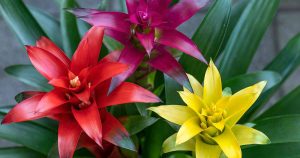
Weigela spp.
Weigela, Weigela spp., is a genus of deciduous woody shrubs in the Caprifoliaceae or honeysuckle family.
It is suited to cultivation in USDA Hardiness Zones 4 to 9, displaying masses of showy, trumpet-like blooms from late spring to early summer, with occasional lighter flowering later in the season.

We link to vendors to help you find relevant products. If you buy from one of our links, we may earn a commission.
I have found weigela reliable to the point of being indestructible here in the northeast, where neither harsh winters nor my annual hard pruning has ever fazed the shrub.
If that sounds like what you’re looking for, read on!
Here’s what we’ll cover:
Let’s begin with some background.
Cultivation and History
Native to China, Japan, and Korea, there are about 10 species in the Weigela genus and the types available to the home gardener are generally hybrids and cultivars of W. florida, aka “old-fashioned weigela.”
They typically bloom on old wood in the spring and on new wood periodically throughout the growing season.

Flower colors include pink, purple, red, white, and occasionally, yellow, though yellow blooms are quite rare.
The leaves are serrated, elliptical, and opposing. They may be almost black, burgundy, green, purple, or variegated.
The shrubs have a rounded form with dense, multi-stemmed, upright growth that branches and arches downward.
Mature dimensions are about six to 10 feet tall with a spread of nine to 12 feet, but cultivated varieties are generally smaller, so when you are shopping be sure to read all plant descriptions closely.
Scottish botanist Robert Fortune is credited with bringing W. florida to England in 1845. It was the first species in a national collection that grew as more plant hunters added specimens discovered abroad.

The genus name honors Swedish-born German scientist and professor of botany and multiple disciplines, Christian Ehrenfried von Weigel.
From public gardens to the home landscape, weigela is prized for its abundant blooms, easy cultivation, lack of pest and disease issues, and low maintenance care requirements.
Let’s talk about starting one at home.
Weigela Propagation
Home gardeners can start a plant in three ways: from seed, via stem cuttings, or by transplanting a nursery start.
Here’s how:
From Seed
Weigela seeds do not have a high germination rate and may take a month to sprout.
It’s important to note that seeds collected from existing plants most likely will not grow true to the parent plant, as many of these are hybrids.

To start weigela from seed, fill a seed starter tray or three-inch starter pots with well-draining potting soil or seed-starter mix.
Moisten the medium and surface sow the seeds, as they need light to germinate.
Set the tray or pots in a location indoors with bright, indirect light, and maintain even moisture and provide bright, indirect sunlight.
Overwinter indoors or in a greenhouse and transplant the seedlings to the landscape the following spring.
From Stem Cuttings
In early summer, just after flowering, there is a flush of new foliar growth. Cut a soft stem six inches long from the branch tip. Make the cut just below a pair of leaves, a natural growing point.
Remove the bottom two leaves and pinch off the tip growth to retain one or two pairs of leaves in the middle.
Fill a six-inch-deep container three-quarters full of potting soil.
Dip the bottom of the stem into rooting hormone powder.
Poke the stem into the soil deep enough that the lowest pair of leaves is just above soil level.
Place the container in bright, indirect sunlight indoors or a sheltered, sunny outdoor location.
Keep the soil evenly moist, never letting the container completely dry out.
New leaves signify successful rooting and readiness for transplant.
You can also use hardwood for cuttings, but as these take longer to root, you’ll need to keep them indoors until the following spring and then transplant them to the garden.
By Layering
If you have an existing plant, it’s easy to propagate via layering, which you can do at any time during the growing season. Here’s how:
Select one of the lowest branches that grazes the ground.
Using a knife, carefully scrape off a one-inch section of bark and cambium to reveal the inside of the stem.
Lay the branch on the ground. Note where the area that you scraped touches the soil.
Make a shallow well in the soil beneath the scraped portion to set it just below the soil surface.
Mound about two cups of soil on top of the scraped portion to keep it in place. You can put a rock on top of the soil for a more permanent hold. Contact between the scraped section of branch and the soil generates root growth.
Leave the layered branch in place until the following spring.
When you remove the rock and the top layer of soil, you’ll find the scraped portion is attached to the ground because it has sprouted roots.
Sever the branch six to eight inches below the rooted portion to detach it from the shrub.
Dig at least eight inches deep under the rooted portion to lift it and plant the entire clump elsewhere in the garden.
Transplanting
Transplant seedlings, rooted cuttings, and nursery plants out into the landscape at least eight weeks before the first frost.
Work the soil to a crumbly consistency, and dig a hole the same depth and two to three times as wide as the current pot or the root ball of the shrub.

Set the plant in the hole so that the crown where the stems and roots meet is slightly above ground level. Mounding promotes good drainage, which is essential for successful establishment.
Backfill and tamp the soil to secure the plant in an upright position. Water well and tamp again.
Maintain even moisture when the plants become established.
How to Grow Weigela
As mentioned, weigela shrubs are hardy in Zones 4 to 9, depending on the cultivar. Choose a location in your landscape with full sun to part shade and average, well-draining soil.

The ideal soil pH is slightly acidic to neutral, 6.0 to 7.0. Conduct a soil test either through your local extension office or with a home test kit and amend with compost or humus to increase acidity as needed. Average soil is suitable and clay is tolerated.
Provide an inch of supplemental water per week in the absence of rain during the first year.
Once established, the shrubs are drought tolerant, but like most, benefit from watering during a prolonged dry spell.
If you are growing your weigela shrub in a container, note that pots dry out quicker than ground soil and may require more frequent watering.
Growing Tips
Let’s recap the growing essentials:
- Choose a location with full sun to partial shade.
- Amend the soil as needed for a pH between 6.0 and 7.0.
- Maintain moderate moisture, an inch per week.
With cultural requirements met, your weigela is off to a promising start.
Pruning and Maintenance
In early spring, fertilize with an all-purpose, slow-release, granular product. A 10-10-10 product is suitable.
Moisten the soil and sprinkle the granules in a ring 12 to 24 inches away from the stems to avoid the fertilizer making direct contact. Then, water a second time.
A product to try is Southern Ag All-Purpose Fertilizer 10-10-10, available from Amazon.
Southern Ag All Purpose Fertilizer
This product comes in five-pound bags, contains equal parts of nitrogen (N), phosphorus (P), and potassium (K). In addition to shrubs, you can use it to feed flowers, trees, and vegetables.
After a particularly harsh winter, some old branches or branch portions may die back completely or partially. If they fail to produce any foliage, prune them off at their point of origin.
If they produce foliage at a distance from the tip, remove the portion that is dead by cutting it off just above the first leaf pair.

You may want to cut blooming stems for vase arrangements, if so, make sure you make your cuts just above a pair of leaves to encourage rapid regrowth.
I like to give my weigela a hard prune post-bloom, but never remove more than one-third of the total volume to avoid shock.
Some gardeners grow their weigela shrubs as a hedge, shaping them post-bloom to maintain a rounded or boxed form.
If branches are broken or otherwise damaged, sever them cleanly to remove jagged edges that may fail to heal and invite pests and pathogens.
In addition to pruning, supply supplemental water during a drought, monitor your shrubs for signs of pests and disease, and act promptly to address both.
In fall, in the coldest regions, layer two to three inches of mulch over the root zone without touching the branches for added winter insulation.
Weigela Cultivars to Select
There are many exciting cultivated weigela varieties. Here are a few to whet your appetite:
Crimson Kisses
Crimson Kisses®, Weigela x ‘Slingco 1,’ is a prolific cultivar with red flowers that reblooms reliably from summer to fall.
Mature dimensions are a compact three to four feet tall and wide.
This cultivar is best suited to Zones 4 to 9 and it pairs well with other small-stature shrubs and perennials in mixed groupings.
Crimson Kisses® is available from Burpee.
My Monet
My Monet® aka W. florida ‘Verweig’ is a dwarf variegated variety that features pink flowers and green leaves with cream margins.
Suited to cultivation in Zones 4 to 6, it has a petite stature of 12 to 18 inches tall and 18 to 24 inches wide, perfect for container gardening in small spaces with full sun.
My Monet® is available from Nature Hills Nursery in #2 and #3 containers.
Sonic Bloom
Reblooming Sonic Bloom®, W. florida ‘BOKrasopin,’ is suited to Zones 4 to 8, prefers full sun, and displays waves of bold magenta-pink flowers and green foliage from spring to first frost.
Mature dimensions are four to five feet tall and wide for showy stand-alone specimens.
Sonic Bloom® is available from Fast Growing Trees.
Managing Pests and Disease
Weigela is not generally prone to problems with pests or disease. However, there are some with which you should be familiar.

Pests you may encounter include:
Aphids, four-lined plant bugs, mealybugs, scale, and spider mites are all pests that damage weigela plants by sucking the sap from the stems and foliage.
Telltale signs of infestation are visible pests, leaf holes and deformities, and sticky “honeydew” excrement trails that can attract sooty mold.
A firm spray of water from the hose or treatment with organic neem oil may be all you need to treat them.
Japanese beetles defoliate shrubs by consuming the leaves and are best hand-picked or captured in specially designed traps.
Diseases to be aware of include:
Anthracnose, Botrytis gray mold, and powdery mildew are fungal diseases that can be treated with appropriate fungicides like copper. In severe cases, you may need to prune away affected foliage to curb the spread.
Healthy plants that receive plenty of sunlight and are not under- or overwatered are the least likely to be affected by garden pests and diseases.
Best Uses for Weigela
Weigela is a versatile shrub with many uses in the home landscape.
Some to consider are:
- Border
- Foundation Planting
- Hedging
- Mixed Shrub Grouping
- Privacy Screen
- Stand-Alone Specimen
Let’s brainstorm.
Dot multiple shrubs along a walkway to your front door for a repeating border pattern. Choose cultivars of modest size or prune to prevent obstructing the path. Interplant with companions as desired.
Install foundation plantings to increase curb appeal by softening hard brick and stone lines.

Let the bushes take an informal, natural shape or prune then formally for hedges to divide properties. Keep them low and friendly or high for privacy, as we do below.
In my garden, I enjoy weigela with bee balm, coneflower, dwarf ornamental weeping cherry, and Montauk daisy around my patio. They share similar cultural requirements and are attractive mixed grouping companions.
Create privacy with multiple weigela bushes near property perimeters and around pools.
Select a favorite cultivar and create a stand-alone drift where it can achieve full dimensions and be a focal point in your landscape.
Weigela do not attract deer and tolerate moderate salt exposure, enhancing their durability in both rural and urban settings.
They may attract beneficial pollinators, butterflies, and hummingbirds.
Quick Reference Growing Guide
| Plant Type: | Woody shrub | Flower/Foliage Color | Pink, red, white, yellow/Burgundy, green, variegated |
| Native to: | China, Japan, Korea | Tolerance: | Clay soil, deer, moderate salt |
| Hardiness (USDA Zone): | 4-8 | Maintenance: | Low |
| Bloom Time/Season: | Late spring, summer, and fall | Soil Type: | Average |
| Exposure: | Full sun to part shade | Soil pH: | 6.0-7.0 |
| Spacing: | 9 to 12 feet | Soil Drainage: | Well-draining |
| Planting Depth: | Surface sow (seed), crown slightly above soil level | Attracts: | Butterflies, hummingbirds, pollinators |
| Height: | 6-10 feet | Companion Planting: | Bee balm, coneflower, dwarf ornamental weeping cherry, Montauk daisy |
| Spread: | 9-12 feet | Uses: | Border, foundation planting, hedging, mixed shrub grouping, privacy screen, specimen |
| Growth Rate: | Moderate | Family: | Caprifoliaceae |
| Water Needs: | Moderate | Genus: | Weigela |
| Common Pests and Diseases: | Aphids, four-lined plant bugs, Japanese beetles, mealybugs, spider mites, scale; anthracnose, Botrytis gray mold, powdery mildew | Species: | Coraeensis, decora, floribunda, florida, hortensis, japonica |
Why Not Weigela?
If you’re looking for an easy-care flowering shrub that packs a powerful early season punch, it’s time to introduce one or more low-maintenance weigela cultivars to your home landscape.

In the nine years I had the privilege of caring for weigela, I never had a pest or pathogen issue and was rewarded with masses of deep pink blooms.
I can’t say it was a pollinator magnet, as the bees and other beneficial insects seemed to prefer my native bee balm, but it was sturdy, resilient, and dependable. What more could I ask?
Do you grow weigela? Please share your thoughts in the comments section below.
If you found this article informative and want to read more about other landscape shrubs, we recommend the following:









